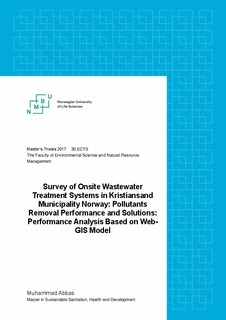| dc.description.abstract | In Norway, 16% of the population lives in rural areas where centralized infrastructure for wastewater treatment is neither cost effective and nor sustainable due to topography and long distance to connect a treatment facility. There are 330,000 small decentralized wastewater treatment plants in Norway and out of those 1,500 plants are located in Kristiansand municipality. Eutrophication and fecal contamination in the recipients are the major cause of concern to wastewater disposal from such onsite systems. In order to avoid pollution in the wastewater recipients from such onsite treatment systems, City and Community department (By- og Samfunnsenheten) of Kristiansand municipality initiated a project to inspect and registration of all small onsite wastewater treatment systems in the locality. However in the first phase (June-August 2016), almost 500 treatment systems was surveyed and out of those 406 treatment systems are analyzed for this thesis through WebGIS model develop by NIBIO. The statistics of the survey shows that there are 183 soil infiltration systems, 91 septic tank with direct discharge to the recipients, 42 with no treatment and direct discharge to recipients and 18 package treatment plants out of total 406 plants. The WebGIS analysis shows that 262 kg of P, 3225 kg N and 4468 kg of TOC per year discharge to different recipients from these onsite systems. Septic tank with direct discharge to recipients, septic tank discharge terrain and sand filter systems significantly contributed to the overall total burden of the pollutants on the recipients. Only these three categories discharge 235 kg of P, 1709 kg N and 3442 kg TOC out of out of total pollutants 262 kg, 3225 kg and 4468 kg respectively. However, it is calculated that if septic tank with direct discharge to the recipients, septic tank effluent discharge to the direct terrain and sand filter systems are upgraded with new system, this may reduce 85% P, 36% N and 69% of TOC. It is therefore, suggested that these systems replaced with new systems because they are significantly responsible for pollution in the recipients. Further, it is recommended that some older infiltration systems should be upgraded with bio-filter system depending on the feasibility. | nb_NO |

